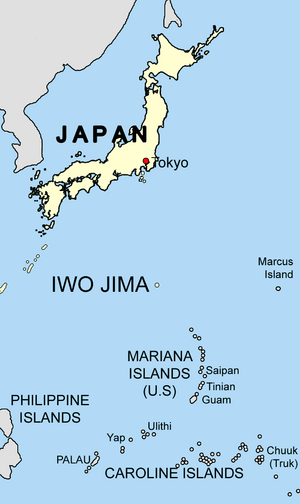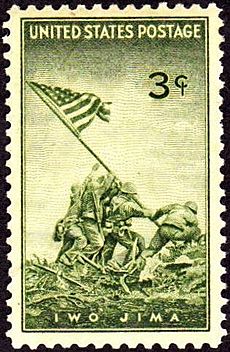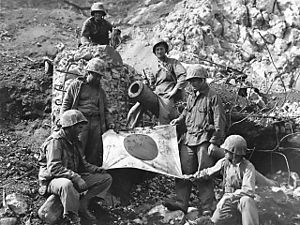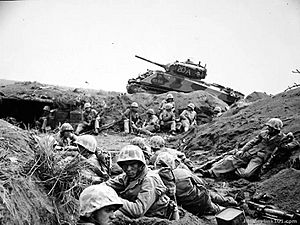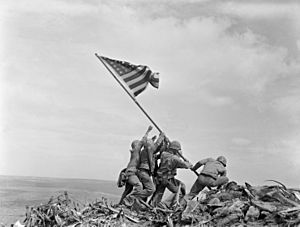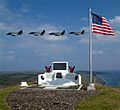Battle of Iwo Jima facts for kids
Quick facts for kids Battle of Iwo Jima |
|||||||
|---|---|---|---|---|---|---|---|
| Part of World War II, Pacific War | |||||||
 A U.S. 37 mm (1.5 in) gun fires against Japanese cave positions in the north face of Mount Suribachi |
|||||||
|
|||||||
| Belligerents | |||||||
| Commanders and leaders | |||||||
| Holland Smith Marc Mitscher |
Tadamichi Kuribayashi † | ||||||
| Strength | |||||||
| 70,000 | 18,061–18,591 | ||||||
| Casualties and losses | |||||||
| 12,822 killed/missing 19,217 wounded |
17,845–18,375 killed/missing 216 captured |
||||||
The Battle of Iwo Jima was a major battle during World War II. It took place on the small Japanese island of Iwo Jima. The battle lasted for five weeks, from February 19 to March 26, 1945.
The United States Armed Forces fought to capture the island from the Japanese Empire. The Americans wanted to use Iwo Jima's three airfields. These airfields would help them launch attacks on the main islands of Japan.
The fighting was very intense and violent. The Japanese soldiers had strong defenses. They built many underground tunnels for protection. The Americans used their ships to fire on the island. They also had full control of the sky.
This battle was the first time American forces attacked Japanese home territory. The Japanese general, Tadamichi Kuribayashi, and his soldiers refused to give up. They had decided to fight until they died.
At the start of the battle, there were about 22,000 Japanese soldiers on Iwo Jima. Only 216 were taken prisoner. Some Japanese soldiers continued fighting for weeks after the main battle ended.
Contents
- Why Was Iwo Jima Important?
- How Did Both Sides Prepare?
- The Landing and Fierce Fighting
- Raising the Flag on Mount Suribachi
- Fighting in Northern Iwo Jima
- Weapons Used
- What Happened After the Battle?
- Was the Battle Worth It?
- Legacy of Iwo Jima
- Medal of Honor Awards
- Movies and Documentaries About Iwo Jima
- Interesting Facts About the Battle of Iwo Jima
- Images for kids
- See also
Why Was Iwo Jima Important?
After the Americans captured the Marshall Islands in January 1944, Japan worried. They thought the Americans would move towards the Mariana and Caroline Islands. So, Japan set up a strong line of defenses.
Iwo Jima was a key part of this defense. It was important for two main reasons. First, it was an air base for Japanese fighter planes. Second, it was a safe place for Japanese ships. Japanese forces also used it to launch air attacks on the Mariana Islands.
The Americans had started bombing Japan daily. This began after they captured the Marianas. The Japanese used Iwo Jima to send radio reports about American bomber planes. Capturing Iwo Jima would stop these reports. It would also give the U.S. a base closer to Japan.
When the U.S. decided to invade, experts thought it would be quick. They believed it would be captured in about one week. However, the Japanese defenses were much stronger than expected.
How Did Both Sides Prepare?
Japanese Preparations for Battle
By June 1944, Lieutenant General Tadamichi Kuribayashi was put in charge of defending Iwo Jima. He knew Japan probably couldn't win the battle. But he hoped to cause so many American casualties that the Allies would think twice about invading Japan itself.
Kuribayashi built very strong defenses. He used heavy weapons like machine guns and artillery. His soldiers dug many tunnels, some as long as 11 miles (17.7 km). They also placed Land mines all over the island.
The Landing and Fierce Fighting
The U.S. Navy and Air Forces started attacking Iwo Jima on June 15, 1944. They bombed and shelled the island for nine months. Each large warship fired for about six hours.
But these attacks did not destroy the Japanese defenses. The American bombings continued until February 19, 1945. This was the day the Marines landed.
About 450 American ships were near Iwo Jima. Around 60,000 U.S. Marines were part of the battle. At 8:59 AM, 30,000 Marines began landing on the island.
The Japanese waited until the beaches were full of men and supplies. Then, they opened fire. Many Marines in the first group were killed by machine guns. Japanese heavy artillery was protected by steel doors. These doors closed between shots, making it hard to destroy the guns. Japanese soldiers also hid in their tunnel system.
With tanks, naval artillery, and air bombing, the Marines slowly moved past the beaches. About 40,000 more Marines landed later. The fighting was extremely violent. The Marines used flamethrowers and grenades to clear out Japanese troops from the tunnels.
Eight Sherman M4A3R3 tanks with flamethrowers helped destroy Japanese defenses. The Japanese soldiers eventually ran out of water, food, and supplies. Most Japanese soldiers fought until they died.
Raising the Flag on Mount Suribachi
A famous photograph was taken on February 23, 1945. It's called "Raising the Flag on Iwo Jima." Joe Rosenthal took the picture. It shows five Marines and a U.S. Navy corpsman raising the American flag. This happened on Mount Suribachi.
The photo became very popular. It won a Pulitzer Prize for Photography. It is an important image of the battle and of the war.
Fighting in Northern Iwo Jima

The Japanese still held positions in the north. General Kuribayashi had several battalions of soldiers and gunners. The Marines' tanks were destroyed by Japanese fire and mines. Many Americans were killed or wounded.
The Marines attacked in the dark without bombing first. This surprised many Japanese soldiers while they were sleeping. On March 8, Captain Samaji Inouye and 1,000 men attacked the Americans. This caused 347 American casualties. The next day, 784 dead Japanese soldiers were counted.
On February 21, a kamikaze air attack hit ships at sea. It sank the escort carrier USS Bismarck Sea. It also badly damaged the USS Saratoga.
By March 16, Kuribayashi's soldiers were still fighting. On March 21, Marines used four tons of explosives to blow up Japanese positions. On March 24, Marines sealed up the remaining caves.
A group of 300 Japanese soldiers attacked Airfield No. 2. After a 90-minute fight, they suffered heavy losses. The island was finally captured at 9:00 AM on March 26.
Weapons Used
American forces used the M2 flamethrower in the Pacific. These were very useful for clearing Japanese soldiers from caves. Marines also had flamethrowers on tanks. However, Iwo Jima's rough land made these less useful. Many other infantry weapons were used, including the famous M1 Garand rifle.
What Happened After the Battle?
Out of 22,060 Japanese soldiers on the island, 18,844 died. Only 216 were captured during the battle. About 3,000 Japanese soldiers hid in the tunnels after the main fighting.
The 36-day battle for Iwo Jima resulted in over 26,000 American casualties. This included 6,800 deaths. In comparison, the 82-day Battle of Okinawa had over 62,000 casualties. Iwo Jima was the only U.S. Marine battle where the Americans had more casualties than the Japanese.
There were no civilians on Iwo Jima during the battle. This was different from other battles like Saipan and Okinawa.
Was the Battle Worth It?
Given the high number of casualties, people still debate if capturing Iwo Jima was truly important. Iwo Jima was not used to launch the atomic bombs on Japan. Those planes left from Tinian Island.
One argument for capturing Iwo Jima was that it could be a landing and refueling spot for fighter planes. However, only ten such missions were ever flown from Iwo Jima.
Japanese fighter planes from Iwo Jima sometimes attacked U.S. forces. But only 11 B-29 bombers were lost because of these attacks.
The Japanese on Iwo Jima had radar. They could warn Japanese forces at home about B-29 Superfortresses flying from the Mariana Islands. However, capturing Iwo Jima did not stop the Japanese radar system.
Legacy of Iwo Jima
The United States Navy has named several ships USS Iwo Jima.
On February 19, 1985, the 40th anniversary of the landings, a "Reunion of Honor" was held. Veterans from both sides attended. A memorial was built, and representatives from both countries shook hands.
The battle remains very important to Marines today. Many Marines visit the island and climb Mount Suribachi. The Japanese government continues to search for the bodies of their soldiers killed during the battle.
Medal of Honor Awards
The Medal of Honor is the highest military award in the United States. It is given to members of the U.S. armed forces who show extreme bravery and risk their lives in battle. This medal is often given after a person has died. It has been awarded only 3,464 times in history.
During the one-month Battle of Iwo Jima, 27 U.S. military members received the Medal of Honor. Fourteen of these were awarded after their death.
Movies and Documentaries About Iwo Jima
- To the Shores of Iwo Jima (1945): An American documentary.
- Glamour Gal (1945): A film about Marine artillery.
- Sands of Iwo Jima (1949): An American film starring John Wayne.
- The Outsider (1961): A film starring Tony Curtis as flag raiser Ira Hayes.
- Flags of Our Fathers (2006): Directed by Clint Eastwood, from the American view.
- Letters from Iwo Jima (2006): Also directed by Clint Eastwood, from the Japanese view.
- Part 8 of The Pacific (2010): An HBO miniseries produced by Tom Hanks and Steven Spielberg.
- Episode 23 from The World at War (1973): A Thames Television Documentary.
- Battle Rats: Iwo Jima (2009) (TV).
- The League of Grateful Sons: A movie by Vision Forum.
Interesting Facts About the Battle of Iwo Jima
- The battle became famous because of Joe Rosenthal's photograph. It shows the raising of the U.S. flag on top of Mount Suribachi.
- The battle lasted for 36 days.
- The Japanese dug an amazing tunnel system. It was about 11 miles (17.7 km) long. They also placed many land mines across the island.
- After the battle, Iwo Jima became an emergency landing site for damaged American planes.
- Two Japanese soldiers managed to hide on the island for six years after the war ended!
- American soldiers outnumbered the Japanese by more than 3 to 1.
- About 6,800 Americans and 18,844 Japanese soldiers died at Iwo Jima.
Images for kids
See also
 In Spanish: Batalla de Iwo Jima para niños
In Spanish: Batalla de Iwo Jima para niños


